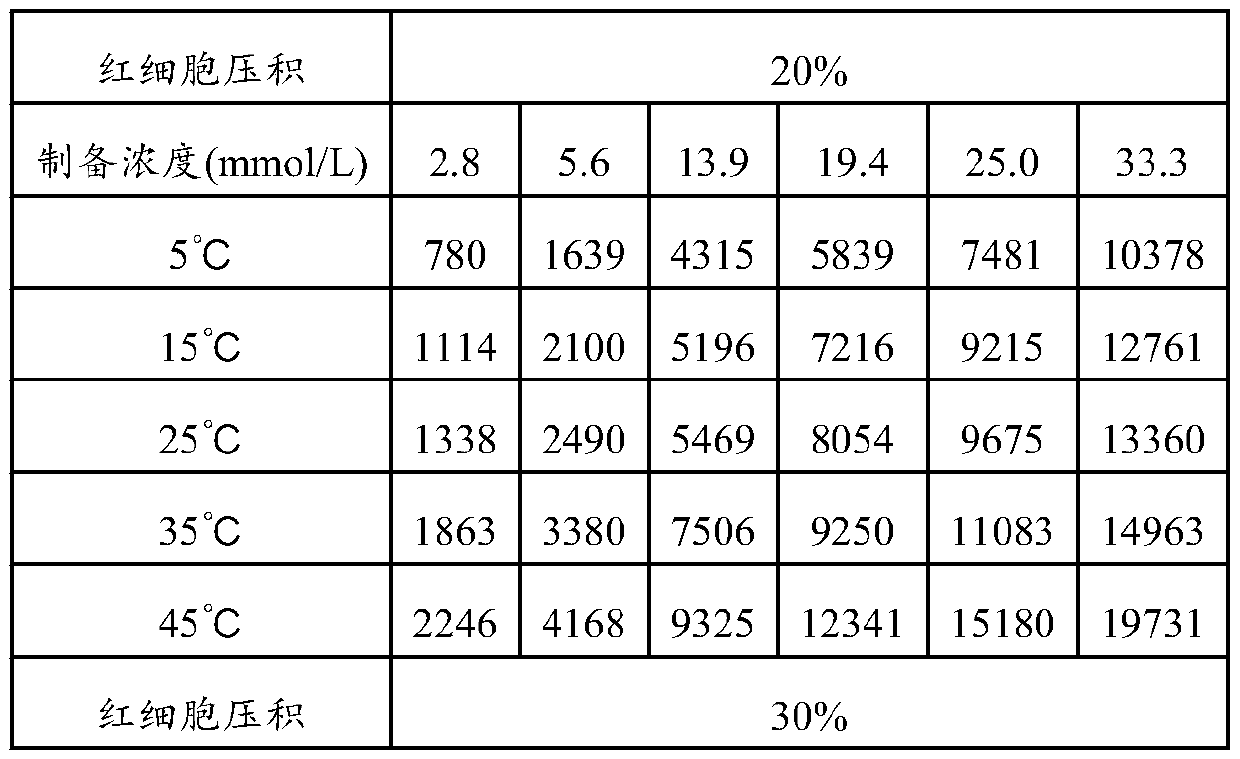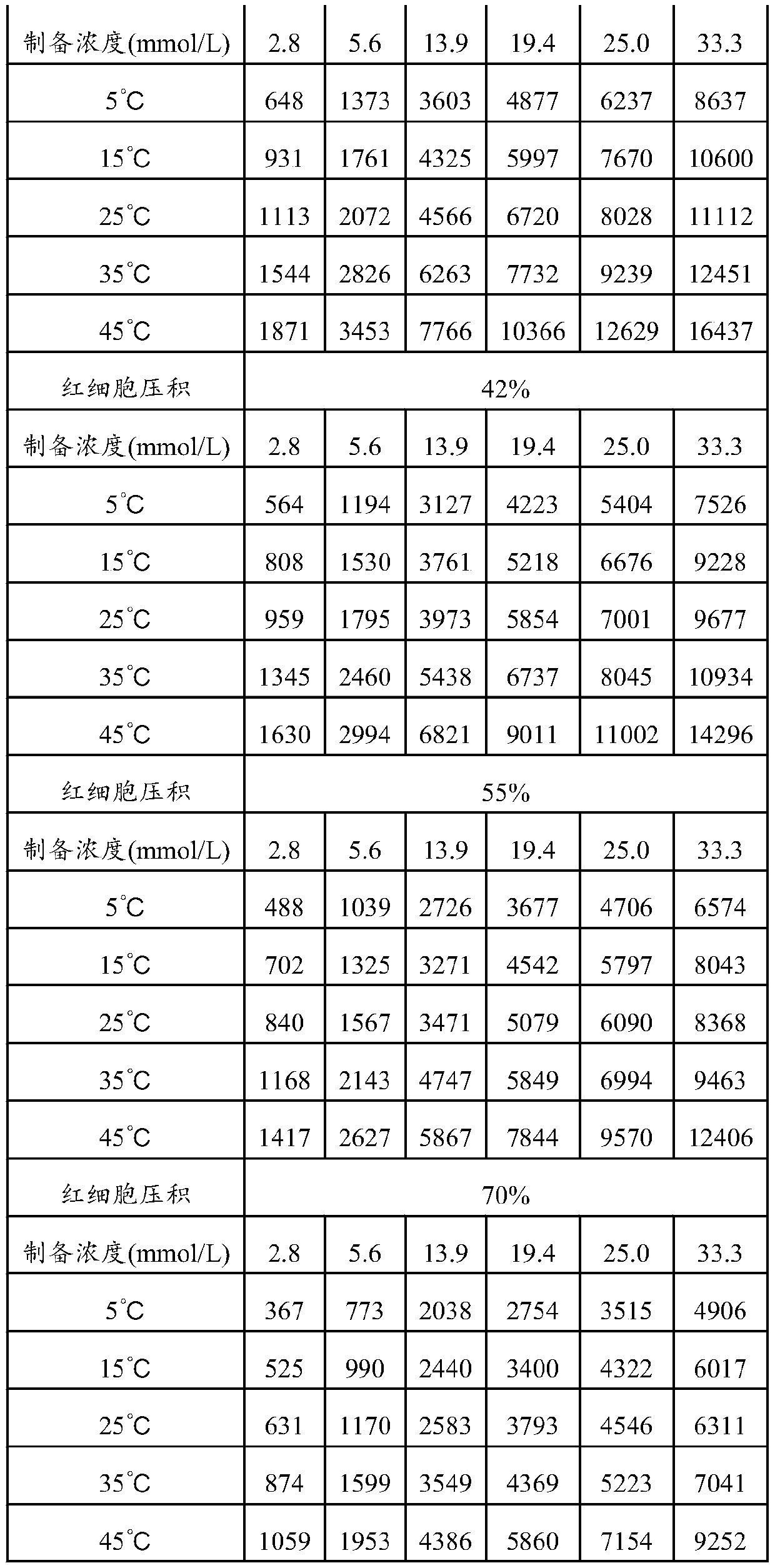Hematocrit correction method and storage medium
A correction method and hematocrit technology, which are applied in the field of hematocrit correction methods and storage media, can solve the problems of large test errors of blood glucose test strips, and achieve the effect of reducing blood glucose test errors and reducing correction steps
- Summary
- Abstract
- Description
- Claims
- Application Information
AI Technical Summary
Problems solved by technology
Method used
Image
Examples
Embodiment 1
[0033] In this embodiment, two variables of temperature and hematocrit are used to compensate the reading of blood glucose concentration. Firstly, venous whole blood with a hematocrit of 20%, 30%, 42%, 55% and 70% was respectively prepared, and the concentration of each hematocrit vein was respectively prepared at 2.8mmol / L, 5.6mmol / L, and 13.9mmol / L, 19.4mmol / L, 25.0mmol / L, 33.3mmol / L whole blood samples, the numerical calibration process in this example is calibrated by a fully automatic biochemical analyzer. Then, test the above 30 venous whole blood samples sequentially at ambient temperatures of 5°C, 15°C, 25°C, 35°C and 45°C respectively, repeat the test 10 times for the same blood sample at the same temperature, and calculate the average value to obtain The test temperature T measured by the blood glucose meter 0 , the electrical signal AD value related to the hematocrit, and the test current I related to the blood sugar concentration 0 , the test results are shown i...
Embodiment 2
[0084] In this embodiment, two variables of temperature and current are used to compensate the reading of blood glucose concentration. Firstly, the hematocrit of venous whole blood was prepared to be 42%±2%, and blood glucose concentrations of 2.8mmol / L, 5.6mmol / L, 9.4mmol / L, 15.3mmol / L, and 27.8mmol / L were respectively prepared. sample. Then, the above-mentioned 7 venous whole blood samples were sequentially tested at ambient temperatures of 5°C, 15°C, 25°C, 35°C and 45°C, and the same blood sample was tested 10 times at the same temperature, and the average value was calculated to obtain The test temperature T measured by the blood glucose meter 0 , and the test current I related to the blood glucose concentration 0 , the test results are shown in Table 9 and Table 10:
[0085] Table 13 Test current I 0 surface
[0086]
[0087]
[0088] Table 14 Test temperature T 0 surface
[0089]
[0090] Execute the above step S2 to set the reference temperature T C =25...
Embodiment 3
[0098] In this embodiment, two variables of current and hematocrit are used to compensate the reading of blood glucose concentration. First, set the test temperature to three constant temperature values of 10°C, 25°C, and 40°C, and the positive and negative fluctuations of the temperature do not exceed 2°C. 30%, 42%, 55%, 70%, and the blood of each hematocrit was configured into 2.8mmol / L, 6.1mmol / L, 19.4mmol / L, 33.3mmol / L blood samples. Then, test the above-mentioned blood samples at three constant temperatures, repeat the test 10 times for each blood sample, and obtain a series of AD values and test current I 0 Value, execute step S1, according to the test circuit amplification operation logic, convert the AD value into the sample resistance value R related to the hematocrit Hct, and according to the correlation equation y=k between the sample resistance value R and the hematocrit Hct 1 *x 2 +k 2 *x+k 3 , calculate the initial hematocrit value Hct 0 value, where y i...
PUM
 Login to View More
Login to View More Abstract
Description
Claims
Application Information
 Login to View More
Login to View More - R&D
- Intellectual Property
- Life Sciences
- Materials
- Tech Scout
- Unparalleled Data Quality
- Higher Quality Content
- 60% Fewer Hallucinations
Browse by: Latest US Patents, China's latest patents, Technical Efficacy Thesaurus, Application Domain, Technology Topic, Popular Technical Reports.
© 2025 PatSnap. All rights reserved.Legal|Privacy policy|Modern Slavery Act Transparency Statement|Sitemap|About US| Contact US: help@patsnap.com



